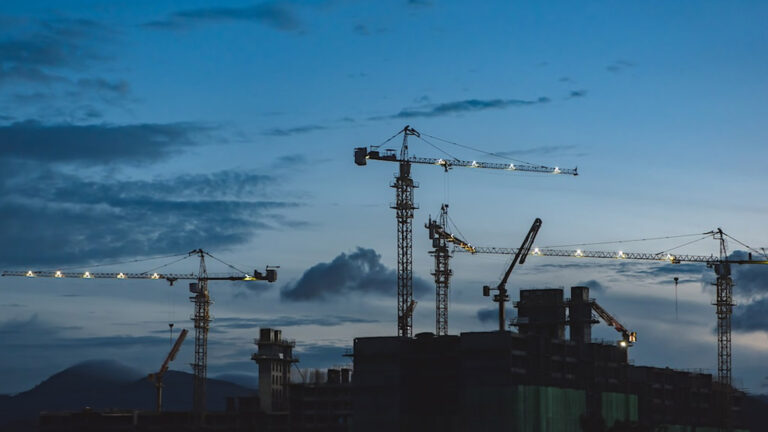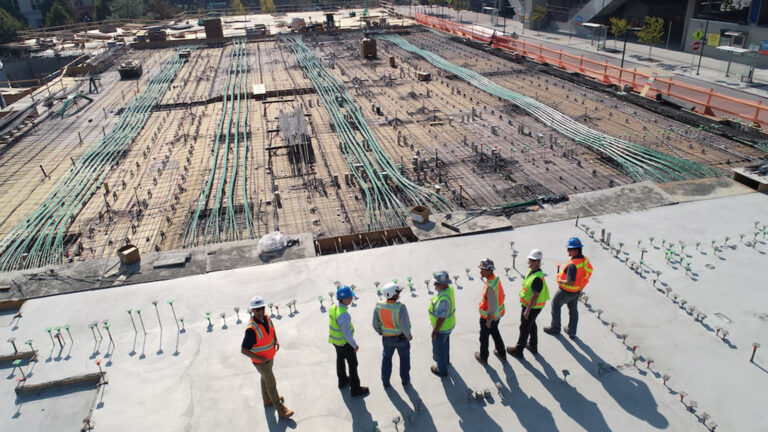
Constructing a successful project is no easy feat – it requires an intricate combination of labor, materials and management. Project Labor Agreements (PLAs) are crucial in order to comply with state and federal laws in the construction industry. This guide will provide you with all the information necessary on PLAs – from grasping their purpose right through to putting them into practice – along with some key considerations for staying compliant. We’ll explore how PLAs can help constructors sidestep disputes, control costs, as well as guarantee efficient operations while studying up on legal requirements covering both private and public projects. Get set to gain meaningful insights into managing a project successfully via effective PLA compliance!
Understanding the Basics of Project Labor Agreements in Construction
Project Labor Agreements, also known as PLAs, are agreements between construction contractors and local labor unions to set the terms and conditions for all workers involved in a given project. These contracts ensure that laborers get just wages while giving contractors an idea of what costs they should expect with regards to labor. The specifics may vary according to regional laws, union stipulations or industry norms; however these must be agreed upon by everyone concerned before any work commences on site. Does this mean it’s harder for new companies entering into such arrangements? It certainly seems so – but is there something else at play here too?
When dealing with Project Labor Agreements for any construction project, there are essential things to think through before signing off on anything. Primarily this includes being familiar with the state laws concerning labor relations – ensure you know the local legislation regarding collective bargaining contracts so your PLA is up-to date right away. It might be worth reflecting here on why compliance at an early stage matters; what obstacles could delaying it cause down the line?
When it comes to Project Labor Agreements (PLA), you should think about whether or not your arrangement needs to cover subcontractors and direct employees. This is important if you are recruiting contractors for any part of the project, as well as protecting yourself against disagreements in the future. Before signing anything make sure that you understand exactly what rights everybody has as stated by the agreement – so there won’t be any shocks further along down the line.
By having a PLA correctly implemented both workers and employers have an exact understanding of wages, advantages, expected actions – which can lead to higher job fulfillment while ensuring predictable labor costs throughout projects!
Significance of Compliance in Construction Projects
Compliance is key when it comes to construction projects, and Project Labor Agreements (PLAs) play an important role. PLAs are legally binding documents between employers and trade unions or other labor organizations that outline the terms of employment for workers on a given project – from working conditions, wages, benefits all the way to any other work-related aspects. In many cases they’re essential in guaranteeing everyone involved follows applicable laws as well as regulations. How do you make sure your team does this?
It’s critical to comprehend the details of a PLA so employers and contractors can confirm that all engaged parties agree with its prerequisites. Not just do this involve ensuring minimum salary standards, but also protecting employees’ rights according to what’s noted in the agreement. Furthermore, bosses must be aware of any liabilities that may arise from not conforming when signing up or negotiating their contract. To make sure full compliance is achieved during the project duration they should consider additional legal requirements such as labor laws or environmental regulations too! Employers ought to make effective plans for quickly resolving disputes if problems occur due to non-compliance throughout execution phase; an essential part of making it work successfully long term!
Analyzing Key Aspects of Labor Agreements
Any successful construction project starts with a labor agreement. It is essential for any company that needs to carry out negotiations and execute this kind of document, to be aware of the components it contains. A well-thought out labor agreement protects both sides while limiting costly disputes or unavoidable delays during works on site. To obtain favorable results from all parties involved in a contract work, it’s important to review thoroughly each key aspect when making arrangements with contractors and subcontractors alike. How can you make sure everyone comes away satisfied?
When it comes to assessing the impact of a potential labor agreement, wages and benefits for workers hired on that specific project must be taken into account. These should include wage rates, job conditions, overtime regulations, vacation compensation and other perks such as health coverage or pension contributions. It is just as vital to think about factors like employment assurance – how long will employees stay employed under the contractor during this particular venture? That being said; these details are fundamental in any negotiation concerning terms of working with an organization.
Both parties must agree on these terms prior to signing the official contract so that any misunderstandings down the line are avoided, which could lead to potential delays in progress or expensive disputes further down the road. Additionally, a significant part of arranging labor should consider safety regulations and protocols for all workers involved in any particular job site. This entails making sure that necessary safety equipment is accessible at all times as well as delineating comprehensive rules when it comes hazardous working activities such as operating heavy machinery or securing mentioned heights. What measures have been taken by either party?
It’s absolutely imperative to define who is responsible for carrying out and respecting the regulations stipulated in your contract. This way, everyone knows exactly where to lay blame if anything goes wrong on site. Additionally, it’s essential that you include language covering conflict resolution procedures in order not to be taken aback by lengthy court proceedings should a disagreement arise later down the line during project execution. To do this, including mediation provisions into your contract can help make sure that both parties involved find an agreeable solution without spending too much time or money trying to resolve things through legal channels instead.
The Role of Project Management in Ensuring Compliance
Project Management is an essential element to guarantee adherence with labor contracts in the construction industry. Project Managers are responsible for making and maintaining agreements between contractors and unionized workers, as well as dealing with any disputes that may occur during a project. By collaborating closely with every interested party, Project Managers can be incredibly advantageous in helping comply to demands of labor pacts by monitoring advancement against due dates and checkpoints. It’s also their job to stay on top of changes or modifications made regarding said unions – which could present itself as a challenge depending on how tight the schedule of each individual project is!
When it comes to Project Management, communication is key. It’s essential that everyone involved has a clear understanding of expectations from the very beginning – when initial bidding takes place right through until completion. A successful project relies heavily on fostering collaboration between contractors, subcontractors and other members of the team so they all know what their roles entail in order for them to meet conditions stipulated by an agreement. How can you make sure this happens? By encouraging open channels of communication with your colleagues throughout every stage of the process! Creating a setting where everyone is on the same page regarding expectations and deliverables should be your goal. That way, all parties involved can receive their respective due compensation or salaries according to what was agreed upon in the contract – while also making sure that work will get done without compromising quality standards. Do you agree? With this kind of environment established early-on during negotiations, both sides are more likely fulfilled as they know exactly what awaits them – with no chance for surprises down the line!
It’s essential for Project Managers dealing with PLA contract negotiations to become familiar with local worker safety laws – from minimum wage requirements, overtime pay rates and hazardous working conditions standards, amongst other considerations relevant in specific states or areas where projects are managed under PLAs guidelines & regulations. Additionally, leveraging collaborative tools such as cloud based software solutions can help project managers set up clear parameters & visibility into how these PLAs should be tracked & measured over time. This kind of setup allows early expectations setting& creates a sense of responsibility among all stakeholders while reducing risks associated when failing to comply to local safety regs.
Incorporating Effective Compliance Strategies for Labor Agreements
It’s absolutely crucial to stay compliant when you’re running a successful Project Labor Agreement. That means having an in-depth knowledge of the intricacies that come along with labor agreements and how to incorporate them into your daily operations without any hitch. To guarantee compliance, it is important to get familiarized with both the fundamentals of these particular contracts as well as the consequences for not meeting their demands – this includes being up-to-date on what federal or state laws may affect your agreement too! Taking care of all these details beforehand can save you loads of time and money later down the line….
It’s really crucial to have good knowledge of the law in place depending on where your project is located. The importance of being aware and timely updated cannot be emphasized enough! You must also get along well with local unions who will need to approve certain part(s) of the contract for implementation. Understanding how a healthy relationship between you & them works would help ensure that no regulations are infringed during construction stages, hence keeping everything compliant. Moreover, it should not be forgotten that all wage requirements as per agreement (or any other applicable terms) must remain closely monitored throughout proceedings too!
Ensuring fairness and competitiveness in wages is essential when it comes to adhering project labor agreements. This means that wage rate of similar roles should be based on industry standards for the geographic area. Moreover, overtime policies need to be clearly defined if they are applicable. Understanding these rules will help both parties involved with their payment without violating any regulations provided by organizations such as OSHA or DOL (Department Of Labor). It’s also important not to overlook proper training for workers regarding safety procedures related specifically to job sites – even though this sounds like an obvious factor initially; failure provide sufficient training could lead into costly legal issues later! So making sure everyone has received appropriate instruction from day one can save time, money and ensure safety during each stage of construction process– which every organization strives towards achieving.
Challenges and Solutions in Navigating Project Labor Agreements
Project Labor Agreements can be tricky and demanding to deal with, particularly in the construction sector. This is because of all the numerous stakeholders involved, multiple rules that need to adhere too as well as regular changes in labor laws. Knowing how precisely maneuver through this minefield requires a thorough knowledge of applicable regulations plus careful coordination and implementation plans. It’s critical for project supervisors to have an exact understanding of what they are accountable for under each PLA agreement so they make sure that every law or regulation associated with it is met properly. What makes matters worse here? How do you handle such intricate agreements correctly?
Getting to grips with project labor agreements can appear daunting at first, but it’s important to comprehend what they are, why we have them and how they could shape a construction job. PLAs are essentially written agreements between employers or groups (usually unions) which stipulate wages, benefits, working conditions plus safety standards on worksites in addition to training opportunities for employees or apprenticeships programs associated with the given construction activity. Additionally these contracts might cover provisions regarding work security as well as dispute resolution processes involving workers. Understanding this whole concept is crucial when you’re about to undertake any building related assignment; all of that information has a role in making sure your endeavor will be successful from start till finish!
When it comes to PLAs, the rules and regulations can differ from one state or industry sector to another. It’s essential for contractors to get up-to speed on what applies specifically in their region before signing any agreement. That way all parties understand exactly which rights and responsibilities they have when committing themselves through a PLA contract. But beyond knowing what makes an official PLA valid where you are working, there is also potential risk involved with managing them that contractors should be aware of. Being conscious about these possible dangers ahead of time will give better clarity into how best handle each situation if encountered down the line.
If there’s poor communication between the stakeholders during the process, it can lead to misalignment in expectations on either side. In addition, if you don’t have proper documentation outlining each one’s rights and duties related to processes or procedures, this may cause misunderstandings when trying to enforce them later. Also, incorrect management from personnel who comprehend both legal aspects of the PLA but also practical boundaries like budget limitations could lead into costly delays due disputes over contract-related matters. Fortunately though we do have strategies which can help making sure PLAs’ successful management; such as actively engaging key players throughout development; putting comprehensive documents defining every party’s responsibilities & privileges ; setting out objectives beforehand; rigorously examining any requested amendments at a midpoint; creating effective lines of communication across groups and bargaining adaptable timetables where practicable ; appointing seasoned staff taking care & supervising progress etcetera .
Case Studies: Success Stories in Mastering Labor Agreement Compliance
Learning from the experiences of others is often a great way to go when it comes to performing case studies. The complexities of labor agreements in construction can be navigated much more easily with success stories as our guide, providing us with invaluable tools for compliant results. Case studies provide useful insight into what works and doesn’t which helps project teams determine potential risks earlier on and develop strategies that’ll help them avoid these problems altogether – how awesome would that be!
It’s really important for employers to know their legal obligations when it comes to Project Labor Agreements (PLA) compliance. Not only that, they need to be aware of all state and federal regulations in place too. To make sure you’re fulfilling these requirements properly throughout the life of a project or contract, case studies can come in handy here; by carefully reviewing them you can take away any lessons relevant for your particular situation – thus helping out with how best respond when disputes arise and what needs doing so agreement specifications are met every step along the way.
It’s clear that employers need to understand the current industry standards for labor practices in order to create contract language which meets all regulations and protects their interests. This knowledge is vital when negotiating with contractors, subcontractors, employees or unions who may work on a project or be involved in its process. Additionally, having an active approach towards PLA requirements will ensure businesses don’t face costly disputes due to lack of enforcement later on. In light of this it would be advisable for companies consider regular audits around PLA compliance before signing agreements and during the duration; these checks should occur at key points throughout each cycle such as pre-award evaluations – allowing them address areas where improvements can be made ahead of time rather than rectifying issues further down line.
Wrapping things up, Project Labor Agreements in Construction can be intimidating. But with the right strategies and compliance awareness at your fingertips, you’re ready to implement these agreements without a hitch… this guide provides an abundance of information on navigating PLAs as well as understanding labor regulations for project management success! Armed with this knowledge – organizations have all that’s required to assure reliable outcomes while still obedience with legal specifications. What more could one need?
Are you feeling overwhelmed by the complexities of Project Labor Agreements (PLAs) in your construction project? Then look no further! Hanthel Consulting have decades of experience to help provide expert guidance and ensure compliance throughout the entire process. Our knowledgeable team will work closely with you offering accurate advice to keep your project on track, plus they are available 24/7 for any questions or concerns that may arise. Don’t attempt this task alone – get in touch today for a free consultation and we’ll make sure all requirements necessary for success are met!



